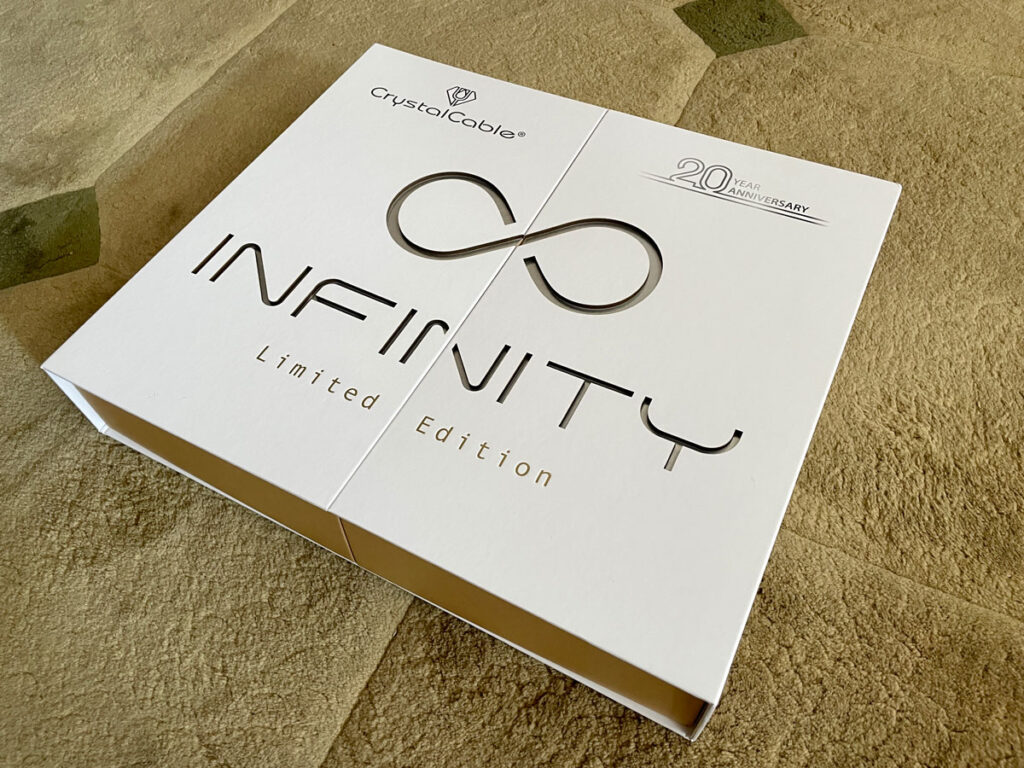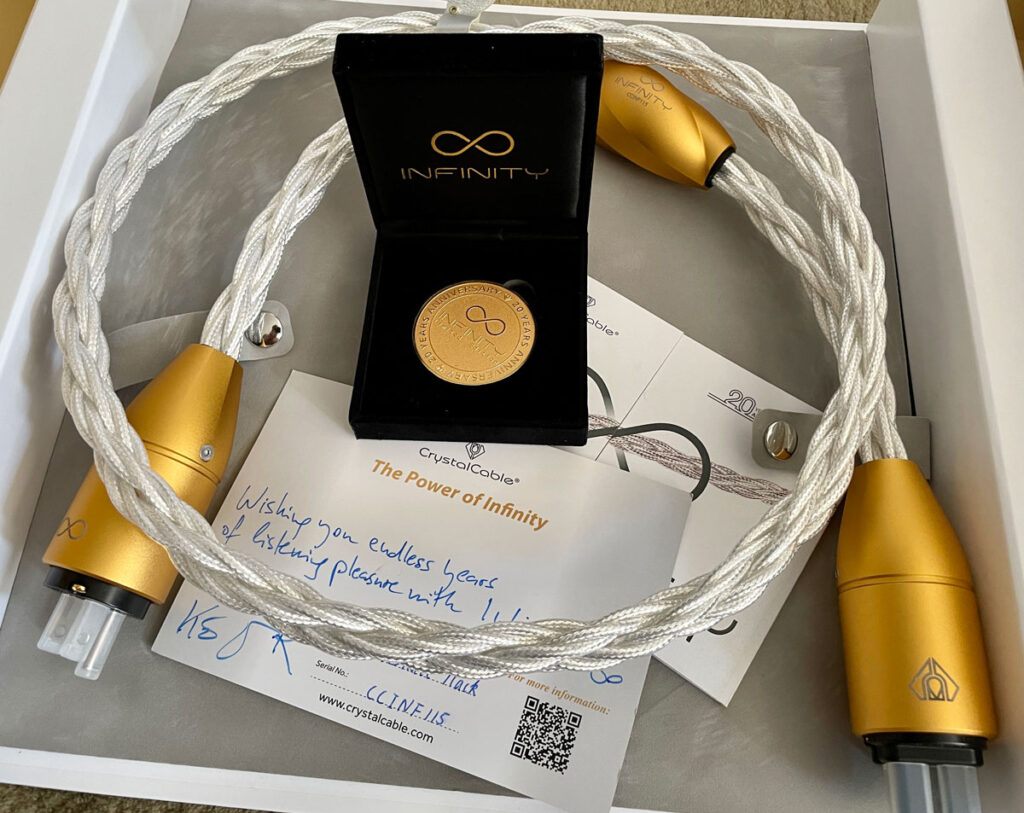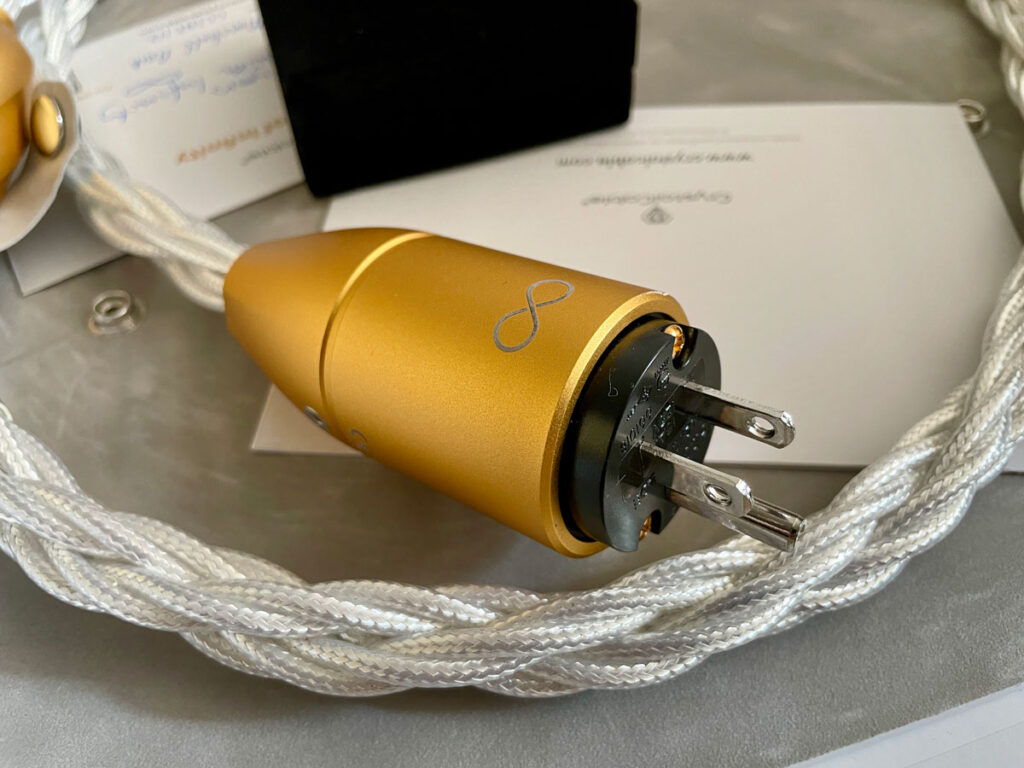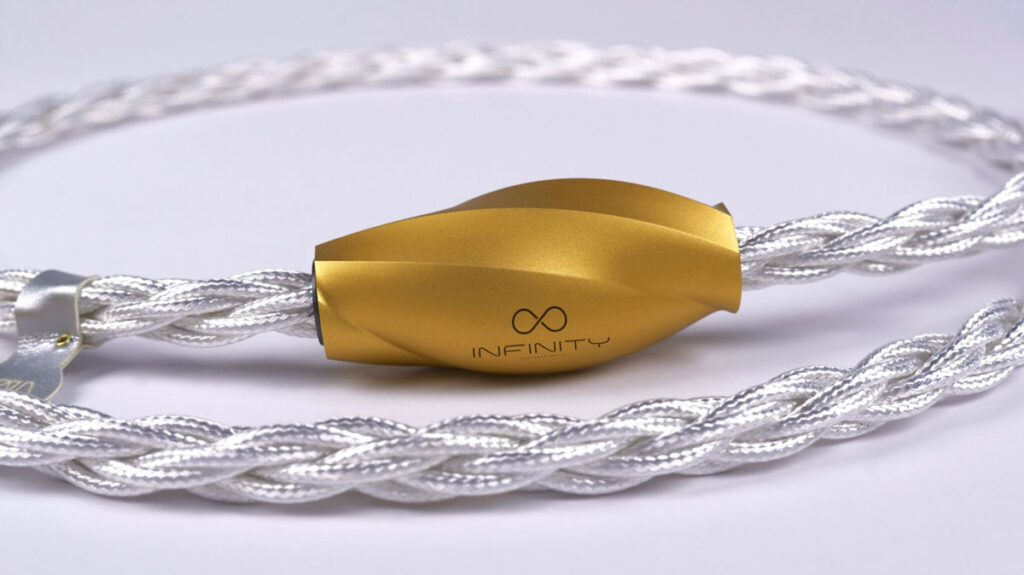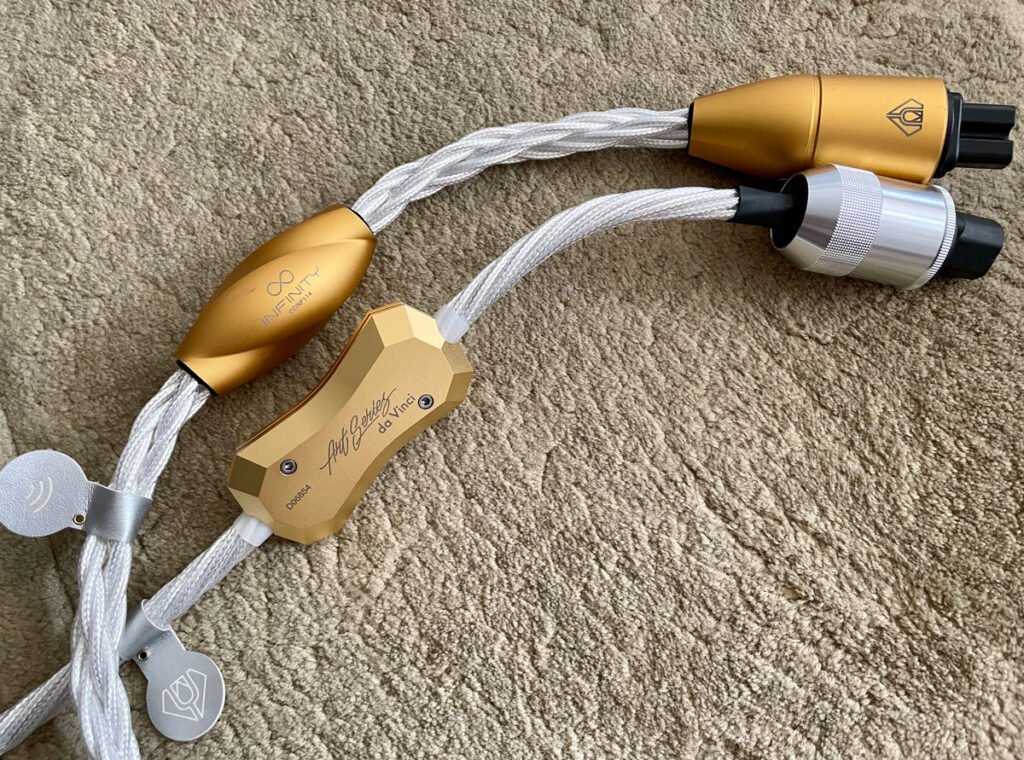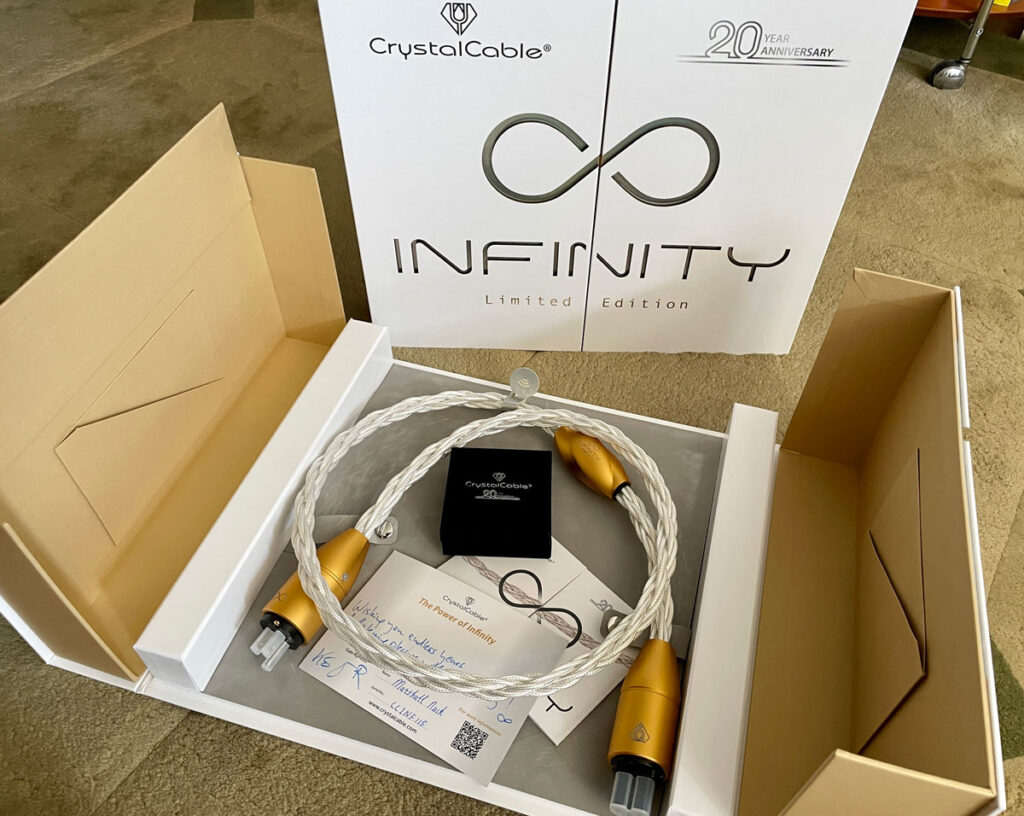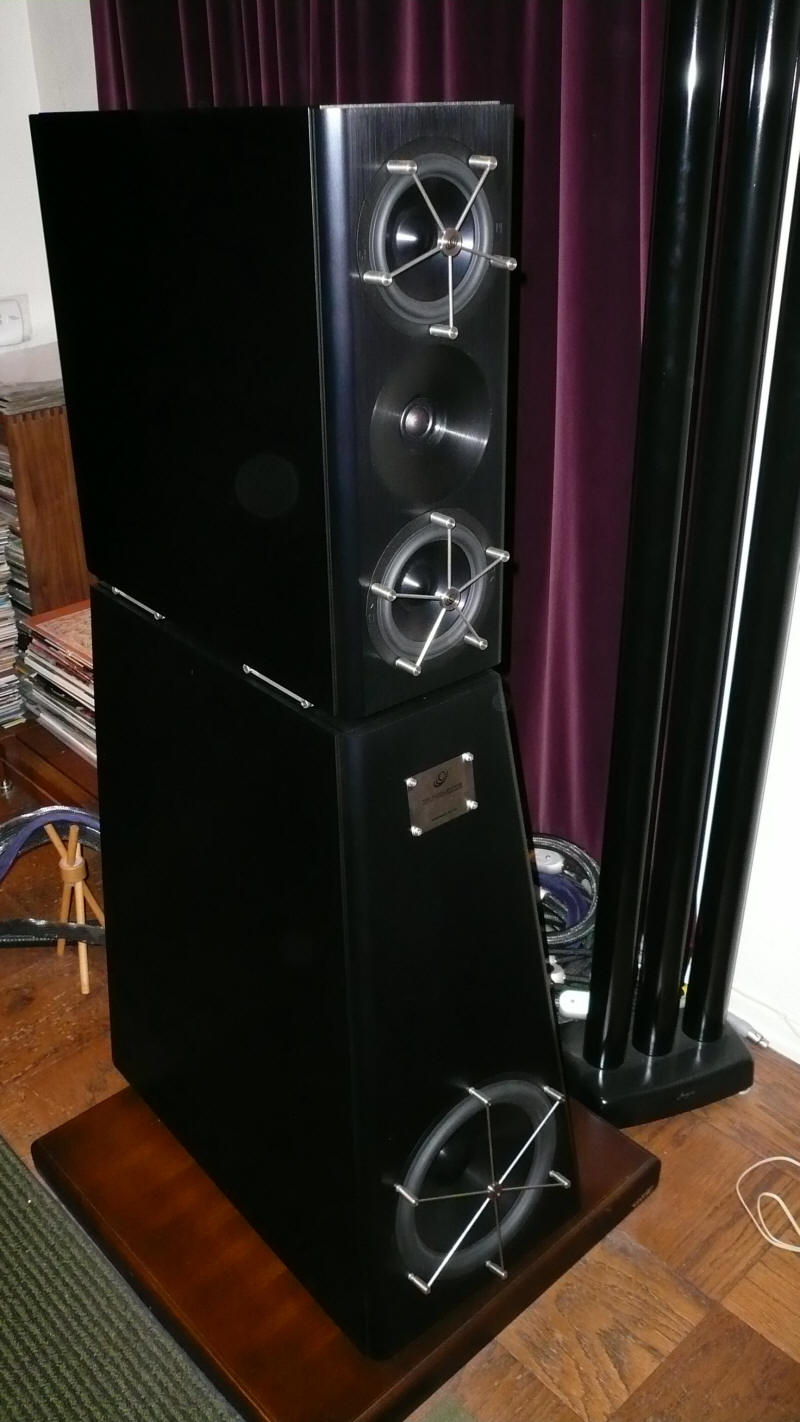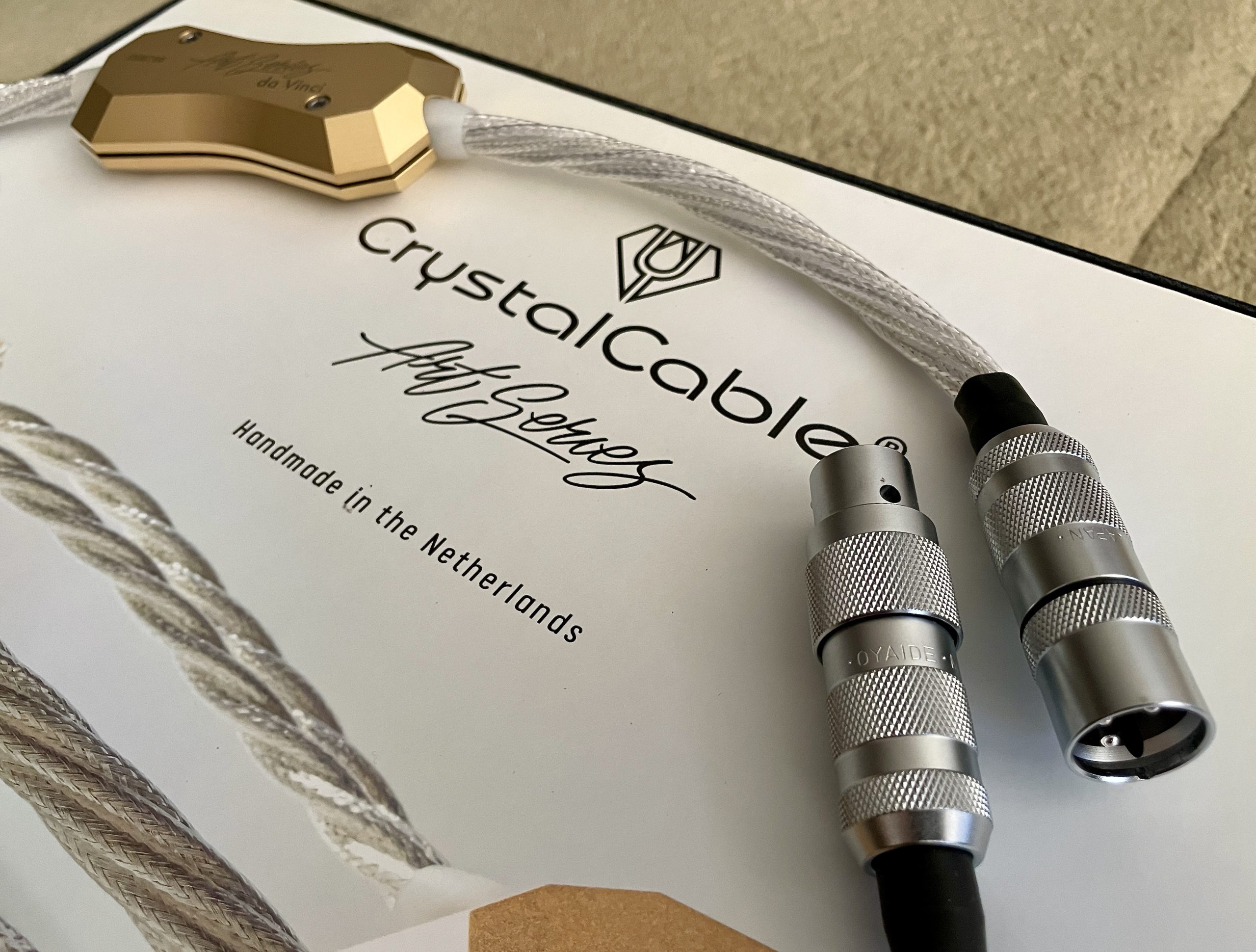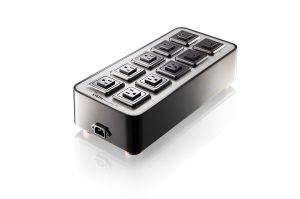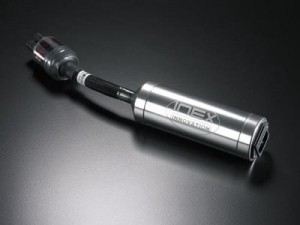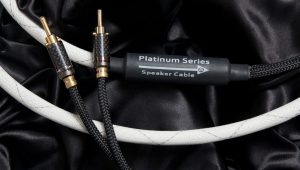Mention Crystal Cable in an audiophile conversation, the adjectives that likely come to mind are thin, elegant, top-drawer fabrication, and expensive. With an unflinching eye on aesthetics, the color scheme has always featured silver, often accented with gold—the regal metals—in a visual palette resembling the colors of a painting. The association with luxury goods has been a constant for over twenty years and, to mark the anniversary, the company has released a limited edition run of the Infinity power cable.
Limited Edition Commemorative Packaging
From the first glance at the laser-engraved commemorative box, it's obvious that no effort or expense has been spared. The delight continues upon opening the clam-shell lid to view the commemorative artifacts within: a medallion and thank-you note from the company's president, Gabi Rynveld. The presentation is like none I've seen before.
But from the look of it, the Infinity suggests a departure. Not in the quality of fabrication and cosmetics, which hew to Crystal's reputation. It's the other adjectives—thin and svelte. I have a couple of Art Series Power Cords in my inventory. Visually, the Monet appear like strings; the Da Vinci like a light-gauge rope; the Infinity is heftier and approaches the girth and bulk seen in other major brands.
The main difference among these power cords is the number of conductor bundles: two in the Monet, four in the Van Gogh, and six in the Da Vinci. The Infinity, which sits adjacent to the Art Series, continues the pattern with nine conductor bundles. They all share the Crystal house sound, but you can definitely hear the enhanced intensity and listener engagement as you go up the line. Those additional bundles have sonic consequences.
Macro Dynamics
What's been on my mind lately is what transpires when an orchestra ascends to crescendo. Seated in the parquet at Carnegie Hall with a world-class ensemble on stage, the sound flattens you to the back of your seat as the majesty and grandeur takes your breath away. A more subtle aspect of the thrill can be described as composure under pressure. I can tell you unequivocally that sound quality holds steady as the SPL rises. Even at fff, the only attributes that change are volume and intensity; it never becomes strident or loses composure. If you talk to a musician, they'll tell you this is a measure of skill. When there are less skilled musicians on stage, sound deterioration, edge, and shrillness creep in as loudness increases.
Ideally, your system should emulate this model of composure under pressure. To that end, I've been searching for products that share this bias. They are as rare in audio as they are on stage.
After installing Infinity PCs on my CH Precision L1 Preamp and D1 Transport, I cued up the Dvořák Violin Concerto with Augustin Hadelich, soloist, and Jakub Hrůša conducting the Symphonieorchester des Bayerischen Rundfunks (Bohemian Tales, Warner Classics CD 527476). Although the discography for this popular concerto is overstuffed, this outing made waves when released. Both conductor and soloist are specialists in Czech romantic music, spinning long lines and generating forward momentum that brings out the thematic material. A top recommendation for classical fans.
Tonal balance is close to the Da Vinci PCs that had been in place—no tweaking or adjustment was needed—only with more body, fullness, and presence. It's when the first crescendo comes along that you'll discover the Infinity power cord has what I'm talking about big time.
When those big orchestral wave fronts roll in, the dynamic range is so extreme that the Infinity sometimes has me riding the volume control. The image of the low-frequency instruments swells grandly along with the SPL, gobbling up large sections of the soundstage. Usually, an active double bass section in an audio system throws a scale miniature, a mere suggestion of the real thing. The Infinity pushes that illusion by a 50% margin. While the Da Vinci can lay claim to some of this prowess, it isn't to this degree.
Yet, even when the orchestra reaches fff, the treble remains beguilingly sweet and instances of shrillness are infrequent. (Except when the recording is meant to sound raw and jagged. The Infinity can do that, too.) Dynamic transitions are smooth and natural, totally avoiding abrupt, step-like gradations. As much as any wire I've heard, the Infinity macros mirror the original source.
Micro Dynamics
I could go on about the macros—they are the stuff audiophiles dream about—but events at the other end of the dynamic spectrum get less press coverage and deserve to be discussed. Audiophiles devote the majority of their efforts and budget in pursuit of slam, understandably so, as that makes the biggest impression. It might also explain why so many systems sound best when played loud, but dynamically flat and uninvolving at low-levels. It's as if they need a certain volume level to open up. Obviously, this is a serious limitation. If your system can't keep you interested when playing low-level material, you're missing out on a lot. So much music is scored piano or mezzo; forte is reserved for the occasional accent.
Just as there aren't many cable brands that hit peak SPLs with quality intact, I haven't found many that address the issues with low SPLs. Crystal Cable has made it something of a specialty. The orchestra crescendos alternate with solo violin passages, often playing at very low-levels. The violin is lithe, fluid, in no way stiff or rigid, and has no trouble speaking in a relaxed, natural manner. Its timbre and tone are gorgeous. Furthermore, the accuracy of these details catches me off guard again and again, suggesting both the absence of artifacts and close fidelity to the source. This is a showcase for micro dynamics done correctly.
Resolution and Soundstaging
The audio lexicon pegs resolution as how well a system conveys the information in the source, details that you might have noticed (or not). Often, these are discrete events: a page turn; an echo off the side wall; precisely when the instruments double up, or sections hand off. In these terms, the Infinity breaks from most other cables to go its own way.
To use a visual analogy of the typical audio den, imagine the speakers projecting their sound in a more or less direct line to the listeners ear. With the Infinity, the instrument's image spreads a bit, the edges soften, and it is surrounded by a cushion of air containing information about the recording venue and the instruments in hyper detail. Even though it plays down discrete events and is more diffuse, its resolution is A+.
The Infinity draws your attention to the entirety of the stage. In place of individual points of sound lined up across the width, the spread is continuous. It resembles a rather large, dense, organic object in front of you in a state of flux. At any given moment, I'm acutely aware of the relative SPLs of individual instruments and orchestra sections emanating from various locations. Decays linger longer. The violin might be finishing its passage when the ensuing orchestral statement is ramping up; quite likely the two will overlap somewhat. Instances of silence between the notes don't happen often, and they never resemble the dark voids that audiophiles go on about so much.
Something I remarked about the DV Interconnect was its ability to organize the source material and make the structure of the score easier to grasp. I speculated it's probably related to coherency in the time domain. This always promotes listener relaxation and the effect is the same with the Infinity in stream. You sink back on the couch, breathe deeply, and let the sound wash over you.
The third Infinity went on the SSCPS power supply for the Kronos Sparta Turntable. Some might question this choice, that it might be a waste of the expensive PC. But I recalled a conversation with Louis Desjardins, who described how he intentionally overbuilt the SSCPS to authoritatively vanquish what he called the primary villain of audio playback: smearing. He compared the SSCPS to a mini power amp. The Infinity loaded it up with premium fuel that greatly impacted macro dynamics, similar to what it did for the CH L1 Preamp.
Design and Construction
Notes from the Crystal website:
The Infinity power cord consists of nine coaxial conductors: three each for positive, neutral, and ground. They are intricately woven into a perfectly symmetrical matrix that maintains absolute geometrical consistency. Such a construction resists induced RF distortion and keeps magnetic interference out of your system. All conductors are individually shielded to protect them mechanically and to offer additional protection from outside interference. Each solid-core central conductor is drawn from the purest possible silver: a single infinite crystal, without boundaries and devoid of intrusive contaminants.
It is then surrounded by two braided layers containing a mix of infinite silver and silver-gold alloy strands. This innovative and complex construction combines the benefits of solid and stranded conductors and our two most advanced metal formulations. Together, they create an ultra-low loss superconductor with almost zero resistance and a cable with vanishingly low source impedance.
Gabi sent an email with further details:
Talking about the construction of the Infinity cable, you can notice that the 9 shielded conductors—actually 18, if we count the complex braid around each conductor as well—are arranged in a very different order from the De Vinci, Van Gogh, and Monet. The Art Series construction is a tight, sleek design, while the Infinity construction is a kind of loose, spacious and flexible matrix of the 9 coaxial wires. Almost see-through, roomy construction, and what you see, you hear it back in the soundstage. Space, breath and deep natural sound—just like the real musical instruments.
Infinity and Da Vinci PCs
Cosmetics
Like the Art Series cables, the Infinity PC has no outer covering, leaving the braided conductor cores visible. As shown in the photo, the Infinity has a much larger assembly of conductors than a Da Vinci PC. That makes it heavy and bulky. Fortunately, it is very flexible and easy to shape around corners. The expensive looking AC and IEC plug coverings at either end are designed for the Infinity. They fit snug and make secure contact.
Nota bene: The AC plug covering is over-sized, which prevented me from stacking them in the duplex outlet of my Audience aR12-T4 power conditioner. They needed to be separated, one to each duplex.
Installation and Burn-in
While the cables are burned-in at the factory, Crystal advises an additional minimum of 100 hours with music after installation. I gave them four days on the Cable Cooker. (Every cable I've tried benefits from time on this burn-in device.) At this point they had a pleasant bulge in the lower midrange, slightly rolled-off top end, and were a bit dark. After another day plugged into their components, the tonal balance flipped and became light and lean. Allow a minimum of a week for them to stabilize and, if you unplug them for some reason, they'll need a day or two to settle in again.
Conclusion
I recently posted a review which shared my thoughts about the audio grail. The gist of it is digital source has improved, but we know it still has issues. The audiophile consensus favors analog at the moment, not infrequently using it to benchmark digital gear. I agree it comes closer to the truth, but we know it, too, comes with distortions, artifacts and colorations. We need to refocus here and get our bearings. Ultimately, the reference point is the sound of unamplified acoustic instruments in a good hall. The real world, right?
Now, along comes the Infinity Power Cord, which caused Lynn to suggest a tweak to that reference, adding the attributes of vitality and presence. The Infinity has all of the things we look for in an audio wire, but the music feels different in the same way that denim cloth feels different from velvet. The Infinity makes you think it's live. If you know what live sounds like, you'll hear this. If your reference is audiophile sound, you might not.
The promotional copy for the Infinity Power Cord dwelled on the brawny aspects of its sound, which gave me pause. As the marketing brochure says,
The Crystal Cable Infinity power cord… deliver(s) pure, unconstrained, and undistorted power. The result is a cable resolving every detail, every dynamic contrast, and every emotion from the musical performance like never before.
I was concerned that the cable might have swerved away from the musical qualities the brand is known for. I needn't have been. The Infinity is Crystal Cable's most musical wire yet.
Infinity Power Cable
Retail: €18.000/1m. €5.500/.5m additional
Crystal Cable




